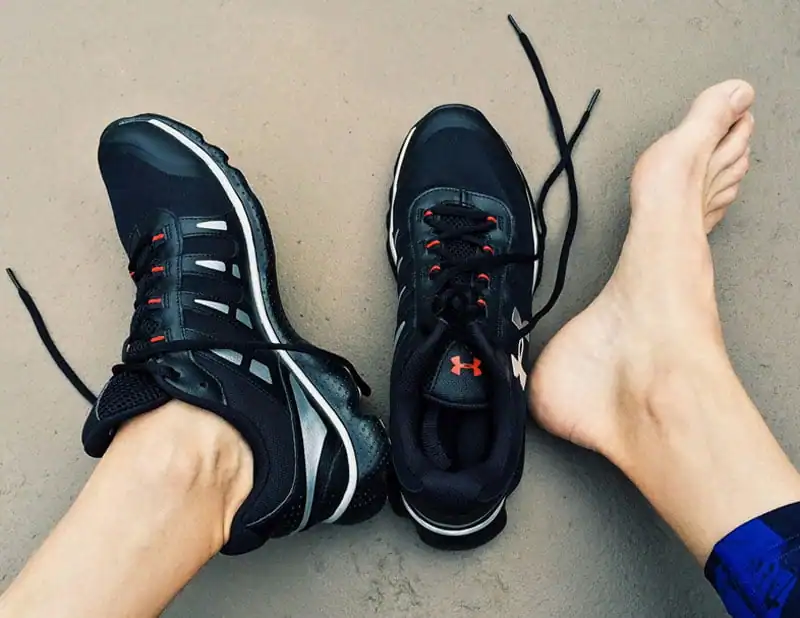Athlete’s foot is a common fungal infection that affects the skin on the feet. It can cause symptoms such as itching, burning, and redness on the skin between the toes. Many people turn to over-the-counter medications and creams to help alleviate the symptoms, but there are also natural remedies that can be helpful in a holistic approach to dealing with athletes foot, such as Epsom salt.
Epsom salt, also known as magnesium sulfate, is a naturally occurring mineral that has been used for centuries to treat a variety of ailments. It has anti-inflammatory and antifungal properties, which make it a tool for responding tp athletes foot.
In this article, I will explore how Epsom salt can be used to treat athlete’s foot, the best ratio of Epsom salt to warm water, how often to soak your feet, and other important information to know when using Epsom salt to treat athlete’s foot!
Does Epsom Salt Help With Athlete’s Foot?
Epsom salt, also known as magnesium sulfate, is a naturally occurring mineral that has been used for centuries to treat a variety of ailments. One of the conditions that Epsom salt is often recommended for athletes foot, a fungal infection that affects the skin on the feet.
Athletes foot is caused by a group of fungi called dermatophytes, which thrive in warm and moist environments. The infection can cause symptoms such as itching, burning, and redness on the skin between the toes. Epsom salt is thought to be effective in treating athletes foot because it has anti-inflammatory and anti-fungal properties.
Although the use of Epsom salt can bring some relief to those suffering from athlete’s foot, it is not a replacement for approved hygiene practices and antifungal treatments. You should see your doctor or a certified podiatrist if symptoms still linger after trying different over-the-counter or home remedies, or if symptoms grow more severe.
How Often Should I Soak My Feet In An Epsom Salt Bath?
In general, most people find relief from athlete’s foot by soaking their feet 2-3 times a week. However, the frequency at which you should soak your feet in an Epsom salt bath to treat athlete’s foot will depend on the severity of your symptoms and how quickly they improve. Ideally, you’ll want to soak your feet until symptoms of athlete’s foot subside.
Keep in mind that while Epsom salt can help to alleviate the symptoms of athlete’s foot, it is not a substitute for proper hygiene and anti-fungal treatment.
What Is The Best Ratio Of Epsom Salt To Warm Water For Maximum Benefit?
The recommended ratio of Epsom salt to warm water for maximum benefit when using an Epsom salt soak to treat athlete’s foot is 1/2 cup of Epsom salt per gallon of warm water. This ratio will provide the right concentration of magnesium sulfate, which is the active ingredient in Epsom salt that has anti-inflammatory and antifungal properties.
It is important to note that the water should be warm, but not hot, as overheating can cause skin irritation.
In addition to using the correct ratio of Epsom salt to water, it is important to soak for at least 20 minutes for maximum benefit. You can also use an additional tablespoon of essential oil, such as tea tree or lavender, which are both known for their anti-fungal properties. Some Epsom salt products are available with these essential oils already provided.
Will Using Only Epsom Salt Be Enough To Cure Athlete’s Foot Entirely?
Epsom salt has effective anti-inflammatory and anti-fungal properties, which can help reduce the intensity of athlete’s foot symptoms like itching, burning, and redness between the toes. Nevertheless, solely depending on Epsom salts is probably not enough to completely cure this condition.
Athletes foot is a fungal infection caused by a group of fungi called dermatophytes, which thrive in warm and moist environments. While an Epsom salt soak can help to alleviate symptoms and contribute to an inhospitable environment for fungus, it will not kill the fungus that is causing the infection.
One of the best ways to avoid athlete’s foot is by keeping your feet clean and dry. Practice good hygiene, such as wearing clean shoes and socks and avoiding sharing personal items like towels and shoes with others. Over-the-counter anti-fungal creams, sprays or powders can also be used to help clear up the infection.
In short, while Epsom salt may provide temporary relief from athlete’s foot symptoms, the best approach is to use it in conjunction with antifungal treatments and good hygiene practices as directed by a medical expert. That way you will have the greatest possibility of achieving full recovery.
Epsom salt soaks alone can help with athlete’s foot symptoms, but there are other products (including other salts) that can help. Here is a product I think of “a nice cup of tea for the feet” that you might want to try:
This Epsom Salt soaking product was specifically formulated for foot related issues. The blend includes a variety of components to help soften and heal your feet - the US manufacturer describes it as "a proprietary blend of Dead Sea Salt, Epsom Salt, Magnesium, Tea Tree, Eucalyptus, Rosemary, Peppermint, Spearmint, and Chamomile". This link goes to the 16 ounce package, but the product listing has a number of other packaging choices available.
Are There Any Other Skin Infections That May Benefit From Using Epsom Salt?
Epsom salt is a great, natural way to reduce the symptoms of many skin infections, including but not limited to:
- Eczema –Treat your eczema symptoms with the soothing effects of Epsom salt. Inflammation and itching caused by this skin condition can be eased through regular applications, resulting in a calmer, less red rash.
- Psoriasis – Psoriasis, a chronic skin condition that causes scaling and irritation on the skin surface, may be relieved by utilizing Epsom salt. Epsom salt is known to reduce inflammation as well as itching related to psoriasis.
- Sunburn – Epsom salt is the perfect remedy to reduce any soreness or irritation associated with sunburns.
- Insect Bites and Stings – Utilizing Epsom salt can help to alleviate the discomfort and itching associated with bug bites or stings, as well as reduce inflammation.
- Other Fungal Conditions – See the separate article on toenail fungus: The Fungicidal Properties of Epsom Salt: Can it Cure Toenail Fungus?
While Epsom salt is applicable for various applications, it should not be substituted for professional medical care. If you are dealing with any skin infection or disorder, it’s crucial to seek the advice of a doctor or dermatologist to receive an accurate diagnosis and treatment.
By supplementing traditional medical care with the prudent use of Epsom salt, you can benefit from its therapeutic properties in aiding your recovery process.
Will Epsom Salt Help With The Odor Caused By Athlete’s Foot?
Epsom salt may help with the odor caused by athletes’ foot, as it can help to reduce inflammation and dry up the skin that is affected by the fungus. This can help to reduce the number of bacteria and fungus on the skin, which can contribute to the odor.
If Epsom salt and top-notch hygiene practices cannot get rid of the unrelenting odor, it is essential to reach out to a medical expert or foot specialist for a proper diagnosis. This smell could be an indication of a far more serious infection that requires professional attention.
Know More About the Condition
For those who are looking for an in-depth analysis of Athletes foot or the medical condition which is called Tinea Pedis – this is the best scientific source I was able to find at the National Library of Medicine.
Final Thoughts
Epsom salt is an excellent natural treatment for athletes foot, and can help to reduce the swelling and itching associated with it. The anti-fungal properties of tea tree oil, peppermint oil, and lavender oil can also help to treat fungal infections while reducing odors.
It is important to remember that Epsom salt should not be used as an alternative to a doctor’s diagnosis and treatment, and if symptoms persist or worsen, it is important to seek medical attention.
Featured Photo by Pixabay








